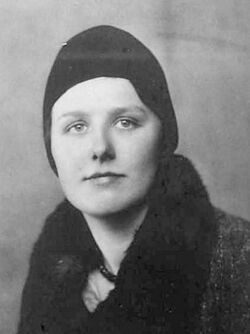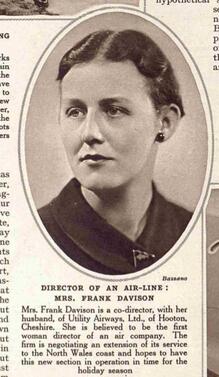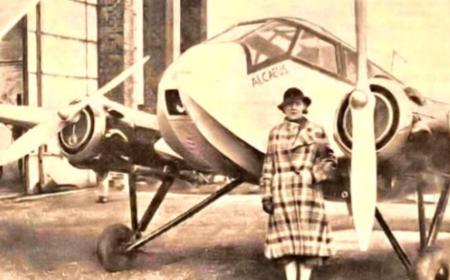 Engineer of the Week No.58: Elsie Joy Muntz (Mrs Davidson) (14 March 1910- 8 July 1940) Today, on the 79th anniversary of her untimely death, we remember Joy Muntz, pioneering engineer-pilot. Joy Muntz, as she was generally known, was a pioneering commercial pilot and aeronautical engineer. Born in 1910 in Ontario, Canada, she lived mainly in England. Her father, Rupert Gustavus Muntz was a clerk who died when she was only 4 years old. Little is known of her early life and education but in 1928 she (and her sister Hope) got jobs as ‘fabric hands’ at De Havillands’ factory where they would have been fitting fabric to the wooden frames of wings and fuselages but luckily for them they did not do the application of the toxic doping varnishes. Joy tried to get work in the drawing office but was turned down. However she did manage to get a minor job in the engineering workshops – stamping numbers on parts – which gave her the chance to apply for a trade apprenticeship (at 6d an hour, the equivalent of 2.5p!) in the engines department. Initially, she was set to cleaning out sumps, followed by the dismantling, cleaning and reassembling of new engines prior to their tests. So she soon knew every part of an aero-engine and started to take flying lessons in her lunch breaks. However that winter she crashed her motorbike, breaking her leg, which put her out of work until October 1929. De Havillands did take her back and set her onto brake testing but the firm’s flying school was about to move to Stag Lane and when she asked to go with it, she was turned down because she was not a ‘premium’ apprentice (ie paying for her training).  Undaunted, she turned to getting more flying hours towards her private pilot’s A licence, which she gained at the London Aero Club in April 1930. She then went on to gain her commercial pilot’s B licence. Whilst studying and practicing for the latter, at the Brooklands Aerodrome, her instructor (Major HG Travers) was so impressed with her notes that he suggested she put them into a book, which she did. “ A Complete Course for the Commercial Flying Licence” was published in 1931, co-authored with Captain W.L. Hope, but her own co-authorship was hidden under a male pseudonym - Norman W. Kennedy. In 1932 she approached Comper Aircraft Company at Hooton Aerodrome (on the Wirral) with an ambitious plan to make a record flight to Capetown in a Comper Swift. Although this never came to fruition she did get a job there as an assistant test and demonstration pilot whilst studying for her Ground Engineer’s certificate. She joined the Women’s Engineering Society in 1932, and wrote occasionally for its journal. After another bout of ill-health she returned to aviation as a demonstration, taxi and joy-ride pilot, first with Blackpool & West Coast Air Services and then piloting planes for aerial photography for the man she would marry in 1933, William Fettis ‘Frank’ Davison (1899-1949). Frank bought Hooton Airfield from Comper in 1936 and registered a new company, Utility Airways, with himself and Joy as directors. For the next 3 years they ran a commercial air-taxi service, scheduled flights around the northwest of England and Scotland and did a lot of demonstration and joy-ride flying. The joy-riding was causing so much concern in Blackpool that the local council forbade them to take paying passengers, whereupon they announced that they would take anyone up for joy-rides, free of charge, resulting in huge crowds of enthusiastic members of the public clamouring to fly. The police had to be called to close the airfield, whilst the matter was argued between the council, the Davisons and the Ministry of Aviation. As the inevitability of war approached, so the company started to do more serious flying, Joy joined the Air Ambulance volunteers and she and the company’s assistant pilot, Anne Longstaffe, flew as ‘targets’ for the Territorial Army to practice anti-aircraft searchlight work on. However, Frank and Joy were divorced in 1939 when he realised he had fallen in love with Anne. When the war arrived, Joy was assigned to fly for the National Air Communications system (which controlled civilian flying), for Portsmouth, Southsea and Isle of Wight. Aviation, based at Cardiff. Then she signed up to be a ferry pilot with the Air Transport Auxiliary but was killed in a training flight when she and her instructor succumbed to carbon monoxide poisoning and crashed their plane at RAF Uphaven. She was very well known in both engineering and flying circles and Pauline Gower, the commandant of the ATA’s women’s section, was among many who wrote to her family with condolences. Her memorial is in Arnos Vale Cemetery, Bristol.
0 Comments
Leave a Reply. |
- Home
- Electric Dreams
- All Electric House, Bristol
- Top 100 Women
- Engineer of the Week
- The Women
- Timeline
- WES History
- EAW
- Teatowels For Sale
- 50 Women in Engineering
- Museum Trails
- Waterloo Bridge
- History Links
- Blue Plaques
- Virtual Blue Plaques
- Career and Inspiration Links
- Contact
- Outreach
- Photo Gallery
- Bluestockings and Ladders

